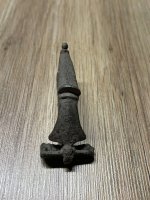BosnMate
Gold Member
- Sep 10, 2010
- 6,916
- 8,441
- Detector(s) used
- Whites MXT, Whites DFX, Whites 6000 Di Pro
- Primary Interest:
- Other
In 1877 the United States Government did the Nez Perce about as dirty of a deal as any of the American Indians they treatied with. The Nez Perce people had agreed to a treaty that assigned them a very large reservation, most of it centered on the Clear Water River in Idaho, a lesser part in the northeastern part of Oregon, west of the Snake river. Gold was found on the reservation, and the white folks wanted it, and they also wanted to settle on reservation land in Oregon, stating that they would put the land to a “much better use,” than a bunch of savage Indians. As a side note, the Nez Perce were raising horses and cattle, they had a breeding program that developed the Appaloosa horse. To this day, the white folks living in that area are still raising cattle and horses. Anyhow, the Nez Perce didn't want to move and were resisting resettlement on a new, smaller reservation on the east side of the Snake.
General Oliver O. Howard demanded they move and gave an ultimatum, “Move in thirty days or suffer an attack by the army.” The Indians moved, but in the process a few of the PO'd young men did a get even raid, and killed a couple of settlers. The Nez Perce crossed the Snake River when it was at flood stage, and never lost a person, and camped in Idaho in White Bird Canyon. Howard followed, and the Indians were attacked, they fought back and defeated the soldiers and volunteers soundly. The Indians then moved their camp to the Clear Water River and Howard attacked again, and was defeated once again. The Indians got away, traveling over Lolo Pass to Montana. The whites had built a fort to block their progress, the Indians went around the fort without a fight, and the fort was named “Fort Fizzle.” Being in Montana, the Nez Perce believed they were home free, they were only fighting Oregon people and didn't understand the concept of the United States, or know anything about telegraph, so they freely traded with the white people as they traveled, buying ammunition and other needed items, and finally camped in Big Hole. General Gibbon and his infantry slipped up on the sleeping camp, and attacked at daylight with orders to shoot low into the Teepees. 80 Nez Perce were killed, and many injured, but the warriors rallied and drove the soldiers back up the mountain, and then kicked their butt. Gibbon was down and out of the fight.
General Howard came up, still following the retreating Indians who had a couple of days start on him.
I've been over the pass where the Nez Perce crossed back into Idaho, and in areas it's choked with lodge pole pines, and there are many places suitable for an ambush, so Howard went the long way around and crossed the Bitter Roots at Monida, Pass, and the soldiers camped at Camas Meadows, Idaho Territory. Here the Nez Perce circled back, and for the only time during the entire 1500 mile retreat they attacked Howard, getting away with the army mules, and putting Howard out of contention until he could replace his mules. The pictures are where this battle took place. The flight of the Nez Perce continued, and they were attacked again at Canyon Creek in Montana, and again they won and got away, but General Miles had been telegraphed, and was moving to cut them off. The Nez Perce were once again feeling confident that they were safe, and stopped to rest a few days, when only 40 miles from Canada. Miles attacked and this time the Indians lost. This is when Chief Joseph, under a white flag, gave his rifle to Miles and told him, “From where the sun now stands, I will fight no more --- forever.”
General Howard camped at Camas Meadows, between two streams, where Camas creek and Spring creek come together. The Indians slipped back and in the pre-dawn hours of 20 August 1877 they attacked Howards camp and got away with at least 150 head of the Army's horses and mules, mostly mules. Among Howard's troops were several companies of 1st cavalry, and one company from the 2nd, Company L under command of Captain Randolf Norewood. Three companies of cavalry, (they weren't called "troops" for several more years) were sent after the Indians, two companies of the first, and company L, 2nd Cav. in the center. In a few miles they caught up with the Indians and attacked. Company L charged up a low ridge and encountered the Indians at 1,000 yards. The number 4's took the horses to the rear, and the rest of the company started taking long range pokes at the Indians. The soldiers were armed with a 45-55 Springfield Carbine, of which I own one, and trust me, at 1,000 yards there is a rainbow trajectory involved, and I doubt the Indians were worried about getting shot. The two companies of the 1st, the left and right wing fell back without telling Norwood, and this movement pulled the Nez Perce after them, which caused Company L to be surrounded. When one of the officers in Norwood's command got a painful wound in the buttocks, they frantically fell back to where the horses were being held.
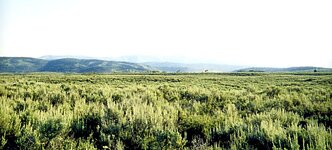
This picture is taken from where the horses were being held looking toward the ridge Company L first rode up on. The trees in the distance are on the low ridge. On my computer this picture was coming up large, now it's a thumbnail and you can enlarge it by clicking on the photo.
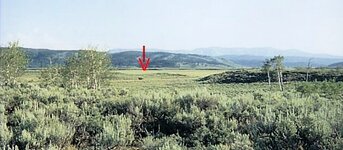
Now I'm standing on the ridge, and the arrow points to where the Indians were first encountered, and the soldiers started taking long range pokes at them.
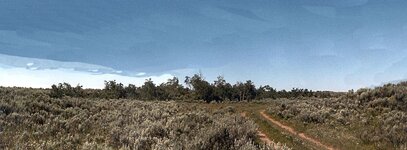
This is where the horse holders had taken cover, and this is where the soldiers fell back to.
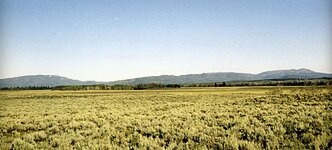
When Norwood was falling back, Bugler Bernard Brooks, 1st Cav, was killed along that line of trees in the distance. This is the only casualty
that Howard reported in his after action report. However, Norwood lost at least two men, one shot in the bladder and he took several days to die, the other shot in the cartridge belt, driving bits of copper and gun powder into the wound. It never healed properly, and he committed suicide later in life.
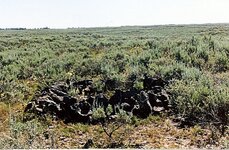
Here is a ring of lava rocks that a soldier built for cover. There are quite a number of these at the battle site.
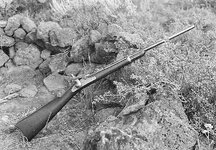 Another emplacement, with my 45-55 Springfield carbine leaning on the rock wall, a gun just like the one the soldier in that
Another emplacement, with my 45-55 Springfield carbine leaning on the rock wall, a gun just like the one the soldier in that
that position would have been using.
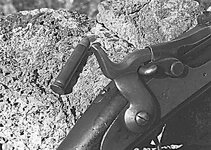
And finally a close up of the carbine, and a cartridge from my collection, just like the one the soldier was using.
Company L was pinned down in that location for several hours, until Howard arrived with the balance of his command, and the Nez Perce withdrew, olny to be pursued by the soldiers for another 6 weeks.
General Oliver O. Howard demanded they move and gave an ultimatum, “Move in thirty days or suffer an attack by the army.” The Indians moved, but in the process a few of the PO'd young men did a get even raid, and killed a couple of settlers. The Nez Perce crossed the Snake River when it was at flood stage, and never lost a person, and camped in Idaho in White Bird Canyon. Howard followed, and the Indians were attacked, they fought back and defeated the soldiers and volunteers soundly. The Indians then moved their camp to the Clear Water River and Howard attacked again, and was defeated once again. The Indians got away, traveling over Lolo Pass to Montana. The whites had built a fort to block their progress, the Indians went around the fort without a fight, and the fort was named “Fort Fizzle.” Being in Montana, the Nez Perce believed they were home free, they were only fighting Oregon people and didn't understand the concept of the United States, or know anything about telegraph, so they freely traded with the white people as they traveled, buying ammunition and other needed items, and finally camped in Big Hole. General Gibbon and his infantry slipped up on the sleeping camp, and attacked at daylight with orders to shoot low into the Teepees. 80 Nez Perce were killed, and many injured, but the warriors rallied and drove the soldiers back up the mountain, and then kicked their butt. Gibbon was down and out of the fight.
General Howard came up, still following the retreating Indians who had a couple of days start on him.
I've been over the pass where the Nez Perce crossed back into Idaho, and in areas it's choked with lodge pole pines, and there are many places suitable for an ambush, so Howard went the long way around and crossed the Bitter Roots at Monida, Pass, and the soldiers camped at Camas Meadows, Idaho Territory. Here the Nez Perce circled back, and for the only time during the entire 1500 mile retreat they attacked Howard, getting away with the army mules, and putting Howard out of contention until he could replace his mules. The pictures are where this battle took place. The flight of the Nez Perce continued, and they were attacked again at Canyon Creek in Montana, and again they won and got away, but General Miles had been telegraphed, and was moving to cut them off. The Nez Perce were once again feeling confident that they were safe, and stopped to rest a few days, when only 40 miles from Canada. Miles attacked and this time the Indians lost. This is when Chief Joseph, under a white flag, gave his rifle to Miles and told him, “From where the sun now stands, I will fight no more --- forever.”
General Howard camped at Camas Meadows, between two streams, where Camas creek and Spring creek come together. The Indians slipped back and in the pre-dawn hours of 20 August 1877 they attacked Howards camp and got away with at least 150 head of the Army's horses and mules, mostly mules. Among Howard's troops were several companies of 1st cavalry, and one company from the 2nd, Company L under command of Captain Randolf Norewood. Three companies of cavalry, (they weren't called "troops" for several more years) were sent after the Indians, two companies of the first, and company L, 2nd Cav. in the center. In a few miles they caught up with the Indians and attacked. Company L charged up a low ridge and encountered the Indians at 1,000 yards. The number 4's took the horses to the rear, and the rest of the company started taking long range pokes at the Indians. The soldiers were armed with a 45-55 Springfield Carbine, of which I own one, and trust me, at 1,000 yards there is a rainbow trajectory involved, and I doubt the Indians were worried about getting shot. The two companies of the 1st, the left and right wing fell back without telling Norwood, and this movement pulled the Nez Perce after them, which caused Company L to be surrounded. When one of the officers in Norwood's command got a painful wound in the buttocks, they frantically fell back to where the horses were being held.

This picture is taken from where the horses were being held looking toward the ridge Company L first rode up on. The trees in the distance are on the low ridge. On my computer this picture was coming up large, now it's a thumbnail and you can enlarge it by clicking on the photo.

Now I'm standing on the ridge, and the arrow points to where the Indians were first encountered, and the soldiers started taking long range pokes at them.

This is where the horse holders had taken cover, and this is where the soldiers fell back to.

When Norwood was falling back, Bugler Bernard Brooks, 1st Cav, was killed along that line of trees in the distance. This is the only casualty
that Howard reported in his after action report. However, Norwood lost at least two men, one shot in the bladder and he took several days to die, the other shot in the cartridge belt, driving bits of copper and gun powder into the wound. It never healed properly, and he committed suicide later in life.

Here is a ring of lava rocks that a soldier built for cover. There are quite a number of these at the battle site.
 Another emplacement, with my 45-55 Springfield carbine leaning on the rock wall, a gun just like the one the soldier in that
Another emplacement, with my 45-55 Springfield carbine leaning on the rock wall, a gun just like the one the soldier in thatthat position would have been using.

And finally a close up of the carbine, and a cartridge from my collection, just like the one the soldier was using.
Company L was pinned down in that location for several hours, until Howard arrived with the balance of his command, and the Nez Perce withdrew, olny to be pursued by the soldiers for another 6 weeks.
Last edited:








